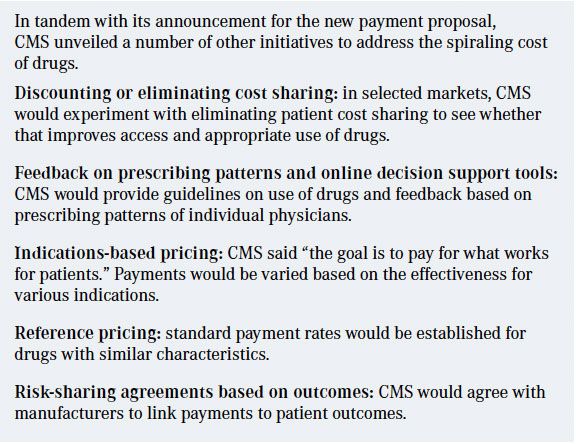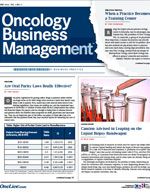Publication
Article
Special Issues
CMS Pay Cut Proposal Draws Fire
Author(s):
A newly proposed drug reimbursement plan from The Centers for Medicare & Medicaid has oncology associations up in arms, whereas a well-known patient advocate and oncologist says he sees method in the payment scheme.
Jennie R. Crews, MD
A newly proposed drug reimbursement plan from The Centers for Medicare & Medicaid (CMS) has oncology associations up in arms, whereas a well-known patient advocate and oncologist says he sees method in the payment scheme. The proposal to change Medicare Part B payment comes with a number of strategies to experiment with pricing, coinsurance elimination, and risk sharing that would be meted out in geographical samplings to see how well they perform.
The most prominent proposed changes to Medicare Part B drug reimbursement would reduce the add-on physician payment from 6% per drug to 2.5%, although a $16.80 per drug, per day payment would be added to the total.1 The plan is designed to make it less enticing for physicians to earn the highest possible payments simply by prescribing the most expensive drugs. The reduced percentage coupled with the daily fee will in many cases improve payments for lower priced drugs while lowering payments for higher priced ones (Table).
Table: Drug Payment Under Current Policy and Proposed Medicare Part B Drug Payment Model
Oncology drugs amount to the highest category of drug spending by Medicare, yet oncology groups contend that there are a number of problems with the newly proposed payment scheme. They said they feel insulted that CMS assumes that they are prescribing drugs according to the most money they can get rather than the best interest of patients. They also said they should have been consulted during the early stages of the planning for this proposed change, and that the 60 day comment period that began March 8 isn’t a fair amount of involvement, considering how the new payment plan may affect their revenues and their practice procedures.
“The focus of this proposal is on cost, not quality,” said Jennie R. Crews, MD, newly installed president of the Association of Community Cancer Centers (ACCC) and medical director at PeaceHealth St. Joseph Cancer Center in Bellingham, Washington. “When choosing an appropriate therapy for patients, the decision algorithm should include efficacy and safety first and then cost.”
On the other side of the argument, Peter J. Bach, MD, director of the Center for Health Policy and Outcomes at Memorial Sloan Kettering Cancer Center, said that there are many aspects of the approach that CMS wants to take that may result in a stronger focus on patient welfare, at lower cost.
“We can develop more reasonable ways to price drugs if we are going to help patients and avoid bankrupting Medicare and Medicaid,” said Bach. “We need to price drugs based on transparency and evidence that encourages biomedical research and reasonable profits, and in a way that is affordable for patients who need life-saving treatments.”
Lowering Reimbursement Rates to Promote Value in Cancer Care
CMS Chief Medical Officer Patrick Conway, MD, stated that the goal is to align incentives with what’s best for patients and doctors. He said the proposed changes enable doctors to prescribe what they think is best without preoccupying themselves with administrative priorities. He said the proposed changes are designed not to interfere with doctors’ ability to prescribe whatever they think is best for patients. Multiple patient and provider advocate groups, including the ACCC, ASCO, and the Community Oncology Alliance (COA), have weighed in with objections to the payment plan, contending that it may actually increase overall costs by shifting cancer treatment from the community provider to the more expensive outpatient hospital setting.Crews said that the tremendous increase in prescription drug spending in recent years is to blame for this attempt by CMS to revise physician payments. Spending on drugs in the United States has increased from $356 billion in 2010 to an estimated $457 billion in 2015, according to the US Department of Health and Human Services. Likewise, spending for Medicare Part B prescription drugs, which includes biologics and infusible and injectable drugs administered in an outpatient setting, increased from $9.4 billion in 2005 to $18.5 billion in 2014.
In its proposal to change the system of drug payment premiums for physicians, CMS cited growing concern that the current average sales price (ASP)-based payment for providers (ASP plus 6%) encourages physicians to prescribe higher priced drugs to obtain a larger dollar add-on. Current providers and suppliers of Medicare Part B drugs would be randomly assigned to participate in the new payment model or to continue receiving payments based on the pre-existing system based on their Primary Care Service Areas. The new proposal also would create subgroups within the control and study groups, respectively, to test the value-based pricing strategies listed above.
Opposition Among Community Oncologists
According to Bach, these proposed strategies would be a step toward improving patient access to necessary treatments and developing reasonable drug prices based on efficacy. “Their proposal to reference price is a clear effort to promote competition without restricting coverage,” said Bach. “Their proposal to lower coinsurance makes sense in improving access, and their proposal to evaluate indication specific pricing reflects a key step toward a system that can pay the right prices for drugs even when a particular drug has different uses of different effectiveness.”However, some in the oncology community contend that the proposed changes would undermine the delivery of personalized care. “Because this proposal forces a new reimbursement model on physicians and chooses what regimen they use, it is focused on the cost and not on the safety, efficacy, and tolerance of the treatment,” Crews said.
Bruce J. Gould, MD, president of COA and medical director of Northwest Georgia Oncology Centers, PC, told CMS in a rebuttal letter2 that he takes offense to the “insulting assumption that community oncologists practice medicine solely by financial incentives, not by what is in the best interests of their patients.”
Crews contends that lowering physician compensation for the highest cost drugs may also have the undesired effect of dissuading physicians from prescribing the most effective, newest—albeit, most costly—medications to patients who need them. Such a policy, particularly in the case of Medicare patients, who are often the oldest, sickest patients and need access to multiple drugs, and whose treatment is often a trial-and-error process, would amount to “taking personalized medicine and putting it secondary to economics,” Crews stated.
Another problem with the changes CMS has proposed is that they come at a time when physicians are already grappling with numerous other “value” changes that CMS is imposing and make the job of adjustment much more complicated and dicey, oncology organizations said. Crews said mandatory participation in the Part B payment model could prevent oncologists from participating in the Oncology Care Model (OCM), a yet-to-be launched model for oncology care that is designed to save money and improve outcomes. Hundreds of oncology practices have expressed interest in participating, but CMS has yet to announce which practices will be enrolled in the first engagement of this model.
“The OCM is focused more on implementing quality with a result in shared savings for practices and for CMS,” said Crews. “[The Medicare Part B] proposal conflicts with the goals of the OCM, and it becomes much more difficult for practices to implement the OCM if [the new payment model] is going to be forced upon them.”
Too Much at Once
Further, Crews said, assigning providers and patients to a different reimbursement plan based on zip code is “essentially enrolling Medicare patients in a randomized trial without their consent.”According to Gould, CMS’s implementation of a 2% sequester cut to Part B drug reimbursement, “prompt pay” discounts provided to drug wholesalers, and the additional costs of drug procurement, handling, storage, inventory, preparation, and waste disposal mean that many cancer drugs are reimbursed at less than their cost, even under the current rate of ASP plus 6%. This has increased the financial burden on community oncology practices and led to greater acquisition of community practices by hospitals and consolidation of cancer care in the more expensive hospital setting, he said.

He said that further lowering the drug reimbursement rate would continue this trend and increase delivery of chemotherapy in the more expensive hospital setting.
Gould cited a previous experiment by UnitedHealthcare Group that showed elimination of payment incentives for oncologists “paradoxically increased the use of chemotherapy” by 179%.3 However, the study also noted that the total medical costs were reduced by $33 million as a result of decreases in hospitalization and use of therapeutic radiology.
Resetting Doctors’ Priorities
Crews contends that Medicare Part B drug spending accounts for only about 3% of the total costs of the Medicare program and that CMS is missing the bigger picture on improving patient care. “The real issue is, how do we improve delivery of care?” she said. “But it’s more than just the drugs. It’s ensuring improved quality of life, better utilization of resources, limiting unnecessary spending, and improving quality of care.”According to Bach, the Medicare Part B Drug payment model will encourage physicians to focus on the quality of patient care and the true value of the drugs they are prescribing. “It is my hope that these ideas will combine to create a system that pays doctors for doing what they are trained to do—take care of patients—and reduce how much the money they make from prescribing influences what they do. All of these [ideas] will help the entire health care sector to align and smooth the transition from paying for volume to paying for value.”
Crews and Gould expressed a desire to meet with Sylvia Burwell, secretary of the Department of Health and Human Services, and Andy Slavitt, acting administrator of CMS, to voice their concerns and provide constructive feedback to revise the model. “As an oncology community, we want to help design a better model for addressing the rising cost of cancer care,” said Crews. “I think there is rationale to re-look at this and ask CMS to postpone implementation and come back to the table with us to determine how can we work together to achieve common goals.”
References
- Centers for Medicare and Medicaid Services. CMS proposes to test new Medicare Part B prescription drug models to improve quality of care and deliver better value for Medicare beneficiaries. CMS website. www.cms.gov/Newsroom/MediaReleaseDatabase/Fact-sheets/2016-Factsheets- items/2016-03-08.html
- Community Oncology Alliance comments on Medicare Part B drug payment model [news release]. Washington, DC: Community Oncology Alliance. March 9, 2016. http://www.communityoncology. org/site/blog/detail/2016/03/09/coa-letter-on-medicare-part-b-drug-paymentmodel. html. Accessed March 23, 2016.
- Newcomer LN, Gould B, Page RD, Donelan SA, Perkins M. Changing physician incentives for affordable, quality cancer care: results of an episode payment model. J Oncol Pract, July 8, 2014. doi: 10.1200/JOP.2014.001488


























%20(2)%201-Recovered-Recovered-Recovered-Recovered-Recovered-Recovered-Recovered-Recovered-Recovered-Recovered-Recovered-Recovered-Recovered-Recovered-Recovered-Recovered-Recovered.jpg?fit=crop&auto=format)
%20(2)%201-Recovered-Recovered-Recovered-Recovered-Recovered-Recovered-Recovered-Recovered-Recovered-Recovered-Recovered-Recovered-Recovered-Recovered-Recovered-Recovered-Recovered.jpg?fit=crop&auto=format)
